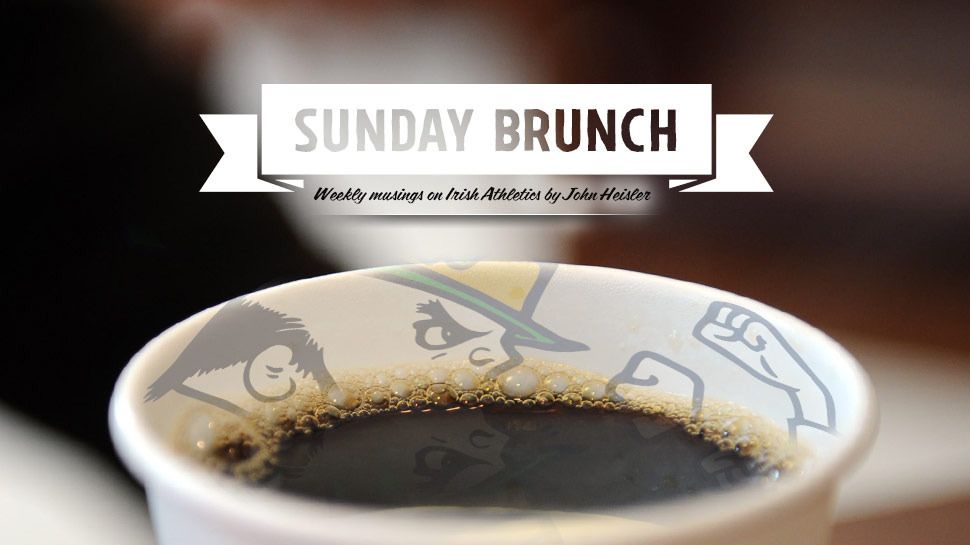Sept. 2, 2017
By John Heisler
University of Notre Dame senior deputy athletics director Missy Conboy has worked in a variety of areas since she joined the Irish athletics administrative ranks in 1987.
For years, she directed the compliance operation. She has served as the sport administrator at various times for a significant number of Irish sport programs, including volleyball, men’s and women’s tennis, hockey, men’s and women’s soccer and women’s basketball. Most recently, one of her primary roles has been to oversee all of Notre Dame’s athletic facilities on a day-to-day basis, including all new construction projects.
It is in that last category that Conboy came to spend much of her last three years determining how the athletic portions of the new construction in and around Notre Dame Stadium would come together.
Originally referred to as the Campus Crossroads Project, it featured a highly detailed series of events and planning that has dominated her life over that period.
This is an extensive oral history of Conboy’s story on how the project has unfolded.
##########
“The project began when (University vice president and James E. Rohr athletics director) Jack (Swarbrick) first presented the idea to the Board of Trustees, and we were given the green light to pursue the concept,” says Conboy, a former Irish women’s basketball captain and a 1982 graduate.
“The first step was to engage in a feasibility study. A committee, comprised of dozens of people representing myriad campus departments, began the process of determining what might work at Notre Dame. In addition, we began to look at stadium projects on other campuses and in professional venues that might have some element of symmetry with what we were contemplating.
“For example, Florida State 20 years ago, created its University Center by constructing four buildings around their football stadium. We traveled to Tallahassee to learn more about that project.
“We also toured Met Life Stadium in the Meadowlands, where they host not one but two professional football teams, in an effort to learn how they crafted their venue to allow for weekly changeovers depending on who was playing.
“We even visited Augusta — unfortunately, when the tournament was not in session — to see the Masters premium hospitality space and to learn from a facility and an organization that has a great respect for tradition.
“And we visited Lambeau Field in Green Bay twice–another stadium imbued with tradition that has recently undergone both a renovation and expansion.
“The question on our collective minds was: How can we learn from the successes, and the mistakes, of other unique or iconic venues and figure a way to frame a project that meets the needs of this University?”
To pull off this project, the University selected one construction management group, several architectural firms and numerous experts and consultants. While initial conversations included the idea of having four buildings around Notre Dame Stadium, it was determined not to put a new structure at the north end, mollifying the population concerned about further diminished view of the Word of Life mural on the library.
“Jack (Swarbrick) said it best — he felt it was important to make this a venue that we would use 365 days a year,” says Conboy. “The stadium (and surrounding buildings) needed to become a destination and not an obstacle for people traversing campus. Through this project, we had an opportunity to take care of some key University needs. Finally, to continue to be relevant, we needed to celebrate tradition while embracing innovation.”
The feasibility project complete, a second presentation before the Board resulted in the project receiving a green light. Swarbrick asked Conboy if she wanted to play point for athletics on the project, and, in addition, he assigned associate athletic director Beth Hunter to her team. Neither had any idea about how much time and energy it would take to deliver a successful outcome. In addition, they didn’t realize the project would morph and grow over the next three years.
“During the early days, the focus was on the three new buildings,” says Conboy. “There was no plan to renovate the stadium itself in terms of the concourses, restrooms and concessions. While we knew the importance of having a great game day facility, the focus appropriately was placed on the three buildings.
“But as the project evolved, there was a collective recognition that if we were providing premium hospitality for some number of fans, we should take advantage of this same construction window to revisit the experience of the fans sitting in the bowl.”
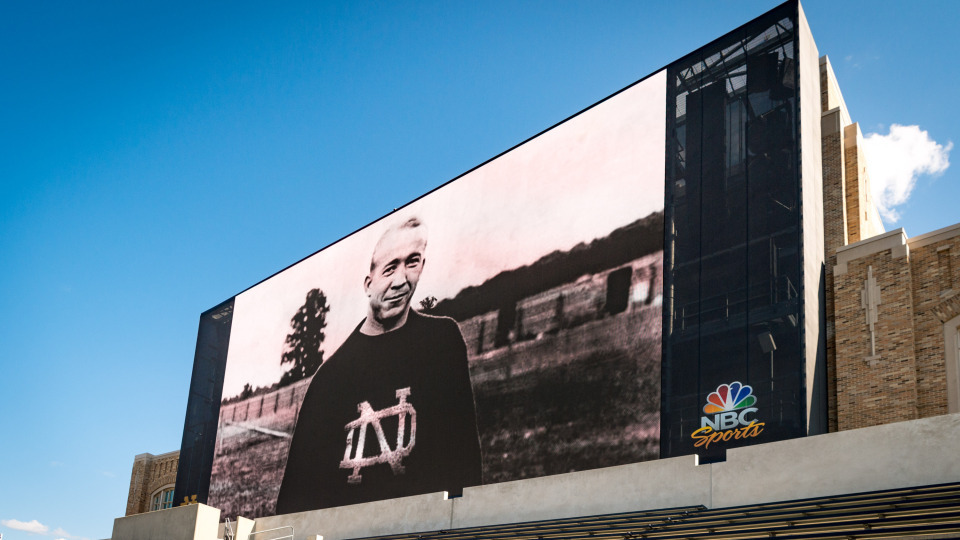
That second phase went on to include new seats, signage, restrooms and concession facades, enhanced Wi-Fi and cellular coverage, a large video board … and a significant artistic facelift.
“To assist with the creative exercise, we engaged the firm ADMI out of California — a group of former Disney Imagineers — to help us think about what story we wanted to tell,” says Conboy. “Jack (Swarbrick) has always placed a premium on this, dating back to my work on Purcell and Compton, and we knew that we needed to get this story right. We also were fortunate to have Julie Boynton, the University’s director of architecture interiors, join our creative team and partner with us for the remainder of the project.
“In the end, the vision was easy to articulate. While it had been touted that we preserved Knute Rockne’s original stadium in the 1996 renovation/expansion, in fact, nothing had been done to celebrate it. Original gate numbers had been removed, and the nail holes remained unfilled. Large concrete pillars were installed in front of the original stadium. While some restrooms were added to accommodate the new seats, no artistic touches or theming improvements were part of the redo. In the end, the first question was, ‘How can we enhance and celebrate the original stadium that Rockne built?’
“We also remembered Jack’s mantra that says Rockne was about innovation. He believed that he (Rockne) would be disappointed if we opted for tradition at the expense of innovation. Rockne built a stadium for 60,000 spectators in a relatively small town back in the 1930s. So while we knew tradition should be a driving force, we had to make sure that we weren’t falling behind with regard to technology.
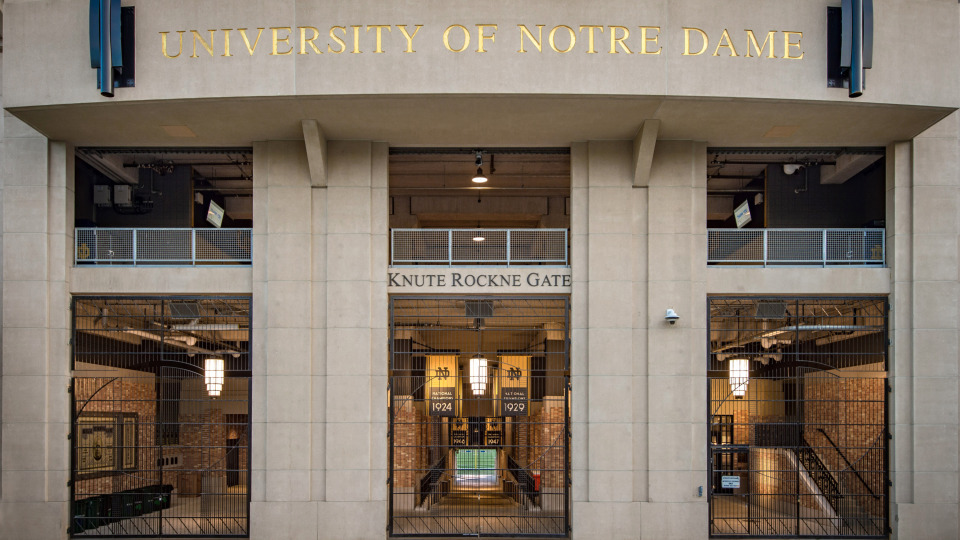
“Early on in the discussion, we knew it would be important to embrace the Art Deco style in which time period the stadium was built. That helped us select the right signage font, the milk glass light fixtures and the old-school dimensional lettering at concession stands. We were looking for very period-specific items to relate to the old stadium architecture. We bricked up over 100 columns, topping each with a stone cap. We canvassed the archives for old football game program and tickets to help tell a visual story.
“But we didn’t want to forget that a more fan-friendly environment was an important outcome. A new sound system plus 150 new video monitors in the concourses mean fans now can follow the action while they are in line at a concession stand or in a restroom. Some concession stands previously could only accept cash–now all can handle credit cards.
“When we looked around the stadium on game day, we saw a lot of people sitting down in a corner or perched on a step. There were not places where you could actually consume your meal — so we looked at installing a lot more benches and drink rails so that people could actually have a place to sit or stand and eat their food.
“ADMI did an incredible job in guiding us through the creative process. We subsequently took the conceptual package and engaged IDS, a Michigan firm that has worked on a number of college stadia in the past, for the more detailed design and manufacturing implementation. In addition, we worked with Cardosi Kiper to design and install the signage and artwork for the various spaces. Champalimaud, the design firm that designed Berkman’s premium hospitality at the Masters, worked on some key interior entertaining spaces, including the South Club and 1842.”
Conboy and her team also helped with additional areas including the corporate spaces and game day operational areas. Perhaps Conboy’s favorite area is the South Club, which features the most extensive amount of historical athletics theming.
Says Conboy, “The South Club features a bar area called Harper’s (after Jesse Harper, the former Irish football coach and athletics director) and there is a nod to every Notre Dame athletic director within that space. In the main dining area, there is a focus on great Notre Dame football teams, featuring past and current images, quotations and various items of historical interest. In the bar dining and chef dining areas that flank that space, the focus is on game day traditions.
“There is a lot of paraphernalia — ribbons, pins, programs, game boards, books — woven into the displays. It’s highly curated and feels like it’s been there forever,” says Conboy. “Champalimaud helped create the experience in the South Club and also in the areas where the (University) president and the athletic director are to make sure we were in keeping with the same level of quality in all of those spaces.”
There are also two corporate spaces. The east corporate club area is known as Seven on 9, a nod to Notre Dame’s seven Heisman Trophy winners, while 9 Southwest features four additional, semi-private boxes for corporate hospitality.
So, phase one featured the three new buildings. Phase two involved upgrades to concourses, concessions, restrooms, plus Wi-Fi, DAS and new seating. So what about the football functionality?
“Late last fall, we began talking about the north end and discussing what needed to be addressed in that area,” says Conboy. “We obviously were not going to change the walk down the stairs and or the Play Like A Champion Today sign. But we agreed it was just as important, if not more so, to insert tradition and technology into these areas as well.”
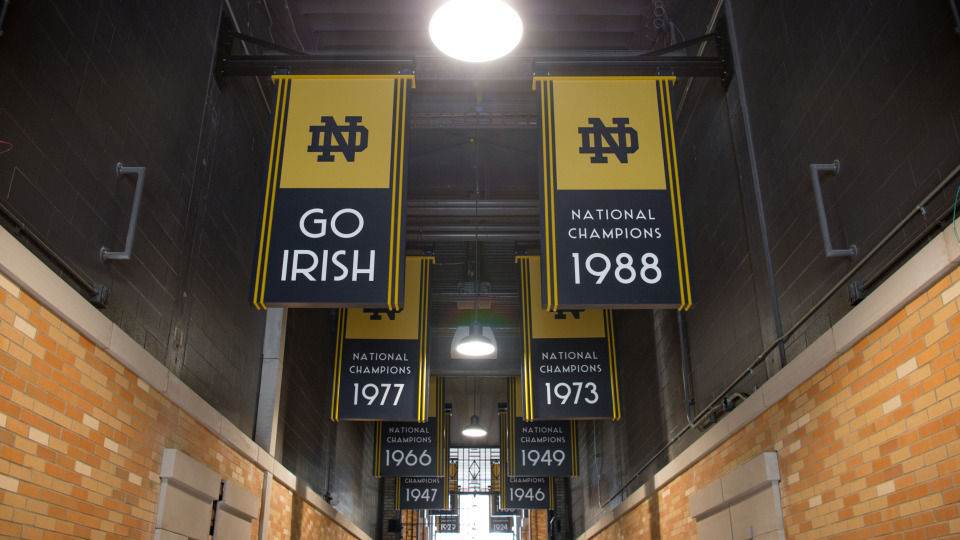
##########
It takes a while for Conboy to do the math.
“I would say probably 50 percent of my time was taken up by Campus Crossroads over the last four years,” she says. “We probably averaged eight to 10 meetings a week and some meetings would go three to four hours, or even the entire day, when we were engaged in detailed design. This project had so many moving parts.
“What we tried to do is create really special spaces that are hopefully a little different than what you’ll find anywhere else in the country. In addition, our focus has always been on community–which is why we chose not to build individual suites. When we watch a football game at Notre Dame, we do it as a community. Individual suites provide a more isolated experience.
“Our challenge was to appeal to a wide range of expectations. While we may need to appeal to the traditional fan, we also wanted to capture the millennial. We know we have to provide a certain ‘wow’ factor for student-athletes and recruits when they visit these spaces.”
Conboy acknowledges that her lens might not always match up perfectly with those of Swarbrick or Irish head football coach Brian Kelly–so that trio shared lots of thoughts and notes on the proposed concepts as the planning unfolded. Chad Klunder, associate athletics director for football operations, was invited to join the design team when it began discussing the north end.
“On the lower level of the stadium, we chose to focus more on the original stadium,” Conboy says. “As you move upstairs it gave us an opportunity to go a little bit more modern because we were not trying to preserve and celebrate the existing structure–that area is relatively new (the 20,000-seat upper-level addition opened in 1997).”
Another part of Conboy’s charge involved working with various entities to update the operation of the stadium. That included projects such as the introduction of an IPTV system to control centrally the new video monitors. With this technology, a menu board can flip to game footage to live postgame coverage.
“And while we are excited about using the video board to enhance the fan experience, we also want to promote important University programs and accomplishments,” she adds. “That’s obviously been a major focus when we’ve played Shamrock Series games, and it’ll be a primary focus here–not to mention the fact this facility will be used at various times of the year to host other events.”
After three years in the design mode, Conboy and her team about six months ago switched more heavily into the operations mode.
“We began to focus on how this would all work on game day, and also during the rest of the year. It’s hard for me to even pinpoint all that this entails,” she says. “It’s housekeeping, it’s athletic grounds, it’s storage, it’s security, access, customer service and so many other things. If this is going to be a 365-day a year facility, you don’t want to walk through the concourse and see tractor trailers and forklifts. We need to store those items so that on the path of a stadium tour or for an event being held in the south or north area of the stadium feels the same on game day as it does the rest of the year.”
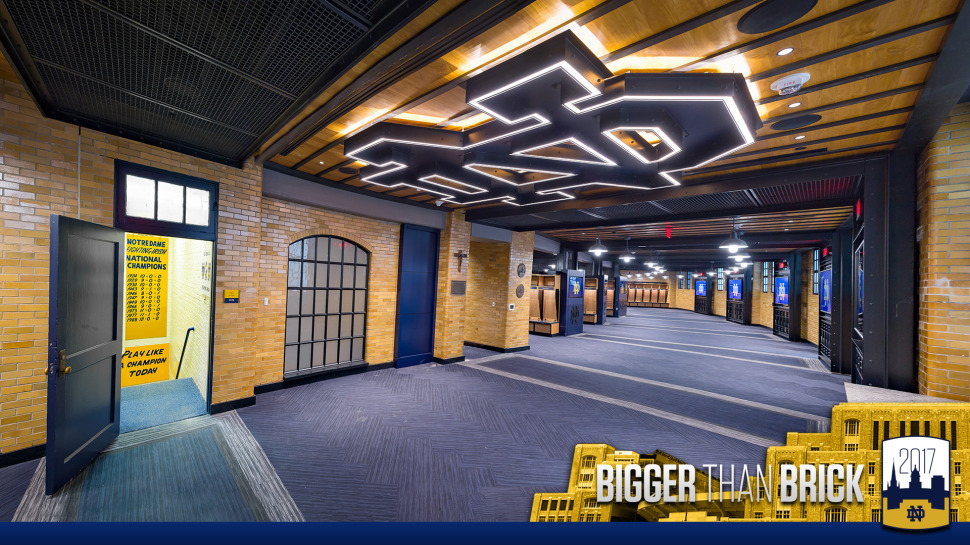
A few other new wrinkles?
While “Welcome to Notre Dame,” has been the traditional greeting for visitors at Irish athletic events, the University again is marrying tradition and innovation this fall by supplementing the ushers with extensive personnel assistance from Chicago-based Monterrey Security.
And while the tradition-rich north tunnel team entrance into the stadium has received a facelift, with all new brickwork, championship banners, renovated locker and recruiting space, and a new media room, it no longer will accommodate the visiting team. The visitors have a brand-new gate, locker room, training room and an exclusive visitors’ tunnel onto the field in the northeast corner of the stadium (where the flagpole previously was located). Only the Notre Dame team, supporters and band will enter by way of the Notre Dame tunnel.
Conboy cannot even fathom how many hours she has spent over the past few years with University vice president/architect Doug Marsh, Boynton and Hunter, as they worked to deliver the best possible outcome. Her attention to detail and passionate zeal for making sure every piece of the puzzle fell perfectly into place paid dividends.
She’s keeping her fingers crossed that everyone from Swarbrick and Kelly to more than 78,000 guests on fall Saturdays will feel they “got it right” as they attempted to create the latest version of an athletic facility icon that all involved hope can last another 87 years.







